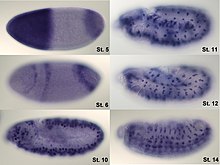
Back تهجين موضعي Arabic Hibridació in situ Catalan In-situ-Hybridisierung German Hibridación in situ Spanish In situ hübridisatsioon Estonian هیبریداسیون درجا Persian Hybridation in situ French Hibridación in situ Galician היברידיזציה באתר HE In situ ハイブリダイゼーション Japanese




In situ hybridization (ISH) is a type of hybridization that uses a labeled complementary DNA, RNA or modified nucleic acid strand (i.e., a probe) to localize a specific DNA or RNA sequence in a portion or section of tissue (in situ) or if the tissue is small enough (e.g., plant seeds, Drosophila embryos), in the entire tissue (whole mount ISH), in cells, and in circulating tumor cells (CTCs). This is distinct from immunohistochemistry, which usually localizes proteins in tissue sections.
In situ hybridization is used to reveal the location of specific nucleic acid sequences on chromosomes or in tissues, a crucial step for understanding the organization, regulation, and function of genes. The key techniques currently in use include in situ hybridization to mRNA with oligonucleotide and RNA probes (both radio-labeled and hapten-labeled), analysis with light and electron microscopes, whole mount in situ hybridization, double detection of RNAs and RNA plus protein, and fluorescent in situ hybridization to detect chromosomal sequences. DNA ISH can be used to determine the structure of chromosomes. Fluorescent DNA ISH (FISH) can, for example, be used in medical diagnostics to assess chromosomal integrity. RNA ISH (RNA in situ hybridization) is used to measure and localize RNAs (mRNAs, lncRNAs, and miRNAs) within tissue sections, cells, whole mounts, and circulating tumor cells (CTCs). In situ hybridization was invented by American biologists Mary-Lou Pardue and Joseph G. Gall.[1][2][3]
- ^ O'Connor, Clare. "Fluorescence In Situ Hybridization (FISH)". Nature Education.
- ^ Gall, JG; Pardue, ML (June 1969). "Formation and detection of RNA-DNA hybrid molecules in cytological preparations". Proceedings of the National Academy of Sciences of the United States of America. 63 (2): 378–83. Bibcode:1969PNAS...63..378G. doi:10.1073/pnas.63.2.378. PMC 223575. PMID 4895535.
- ^ Gall, Joe. "Albert Lasker Award for Special Achievement in Medical Science". Lasker Foundation.
© MMXXIII Rich X Search. We shall prevail. All rights reserved. Rich X Search